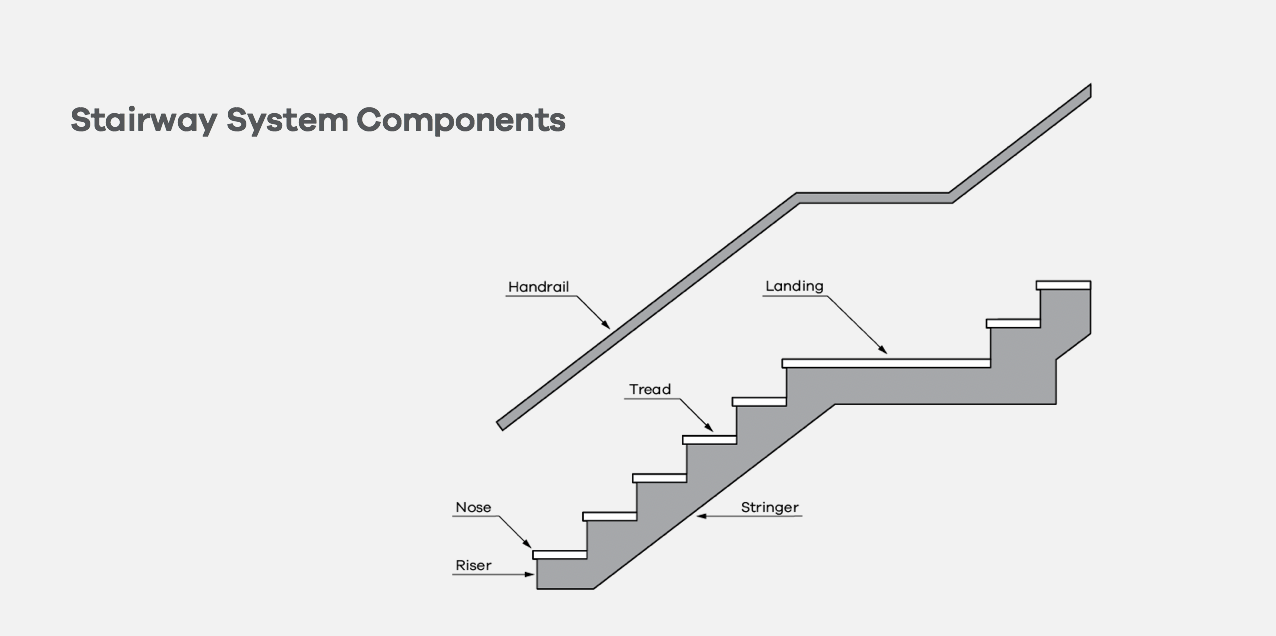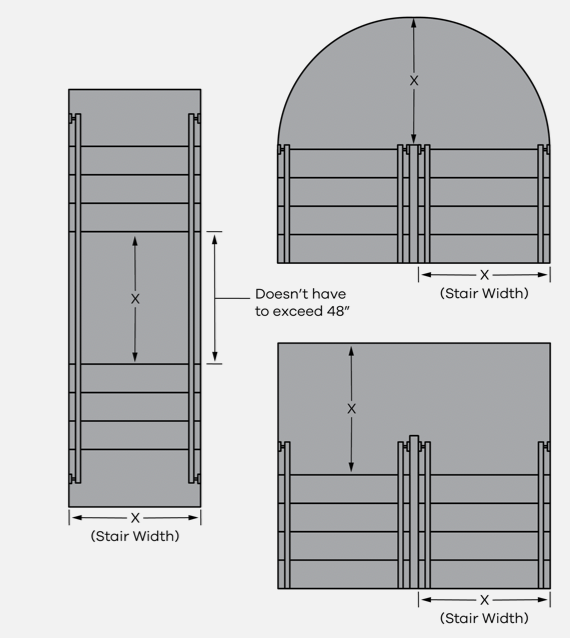Stairs are a large part of creating a functional and safe environment.
When planning commercial buildings, architects are often challenged with maximizing property to get as much usable space as possible. Often this means building up instead of out, which means including stairways. Building designers have to include appropriate exits, which often involves stairs.
As an industry leader, Mannington Commercial offers guidelines regarding stairway systems that comply with both International Building Code (IBC) and the Americans with Disabilities Act (ADA).
Let’s start by examining what goes into creating a commercial stairway system.
Defining the components of a commercial stairway system
Any project starts with understanding the purpose of the endeavor as well as the elements involved. Let’s start with the basic parts of a stairway:
- Tread – the part you step on.
- Nose – the front edge of the tread.
- Riser – the vertical part behind the tread. Combined with the tread, this creates the step.
- Stringer – the vertical part that supports the treads and risers from either side of the stairs or underneath the middle. This can be left exposed or can protect the surface of the sidewall.
- Landing – the flat area between flights of steps or a space used to turn in an interior stairway.
- Handrail – a narrow support for people to hold onto.

These parts combine to create a functional traditional stairway so the materials should also complement each other to work together.
Understanding compliance issues for commercial stairways
The IBC and the ADA have specific requirements that might differ. It’s always smart to check the laws for the local jurisdiction for your project as there can be additional rules. Remember that the requirements don’t just apply to full stairways; the requirements apply to even a single step.
There are a few differences between IBC and ADA requirements. ADA standards apply to all stairs that are part of required egress routes. IBC requirements apply to any stairway serving an occupied portion of a building whether part of an egress system or not.
To clarify, the “means of egress” is an unobstructed path to leave a building, structure or space. So, even a single step leaving a building must meet requirements.
Examining specific requirements of IBC- and ADA-compliance
Now let’s look at some of the individual guidelines for constructing stairways:
- The maximum vertical rise of one flight of stairs is 12 feet. This means there must be a landing every 12 feet.
- A minimum of 6 ft. 8 inches of headroom is required. This is measured up from the leading edge of the treads to the lowest point above the stairs. This could be a pipe or other fixture as well as the ceiling.
- Each stair or tread must be a minimum of 44 inches wide if the building will be occupied by 50 or more people. It must be at least 36 inches wide if the occupancy of the building will be 49 people or less.
- Disabled-accessible stairways are more complicated. There is a 48-inch minimum width requirement – unless there are automatic sprinklers installed, then the minimum width is 44 inches.
- Width is calculated as clear, net, usable, unobstructed space. However, the calculation can take into account handrails, which can encroach on either side by a maximum of 4.5 inches.
Calculating tread width of commercial stairways
This is complicated, no doubt, but there’s a formula for calculating the tread width. In most cases, you can use the equation 0.3 inches times the occupancy load of the stairway. But, if the building has both an automatic sprinkler system and an emergency voice/alarm communication system, use 0.2 inches times the occupancy load of the stairway.
This seems straightforward, right? Unfortunately, there’s another rule that applies: you can never narrow the path of egress. In other words, a stairway can get wider as you go down, but it can never get narrower. Even if the occupancy load is smaller on a lower floor, the width of the stairway has to stay at least as wide as the floor above.
Let’s do an example equation for a four-story building with both a sprinkler system and an emergency communication system:
4th story: 100 occupancy load:100 X 0.2 = 20, which means defaulting to the minimum 44-inch tread.
3rd story: 250 occupancy load: 250 X 0.2 = 50, which means a 50-inch tread.
2nd story: 100 occupancy load: 100 X 0.2 = 20, but because the size can’t narrow on the way down, the tread has to stay at least 50 inches.
The key takeaway is that the tread width can never decrease as the stairway descends; it has to stay as wide as the largest calculation all the way down to ensure traffic flow continues to the exit.
Determining riser, tread and nosing requirements
We talked about tread width, but tread depth has more to do with how an individual person actually walks on stairs than how users as a whole use a staircase.
Tread depth is measured between the edge of the nose on the tread and the edge of the nose on the tread above because when walking down the stairs, you can’t step on the part of the tread that’s covered by the “overhang” of the tread above it.
For both the IBC and the ADA, the 7/11 rule applies: riser height is a maximum of 7 inches and minimum of 4 inches and tread depth is a minimum of 11 inches.
When you’re walking either up or down stairs, you don’t want to have to think about each step, you want to walk with a cadence. This is one reason both the IBC and the ADA require uniformity of risers and treads. It’s safer for everyone.
But, we all know buildings have their quirks, so the IBC allows for a bit of variance. The variation between the highest and lowest risers can be no more than 3/8 inch, and no more than 3/8 inch between the deepest and narrowest treads.
Open risers can provide a pleasing design aesthetic, and are allowed by IBC standards if the opening is narrower than 4 inches. A design element such as a 1.25-inch nose on treads spread 5 inches apart in height could be compliant. But open risers are prohibited by both IBC and ADA guidelines for disabled-accessible stairways. Risers also must not slope more than 30 degrees over the tread below.
The nose or front of the tread has specific requirements for both construction and positioning to ensure safety. First, the nose must not extend more than 1.25 inches over the tread below; this is generous but complies with both sets of guidelines.
The radius/beveling of the nose must be a minimum of 1/16 inch and a maximum of 9/16 inch for IBC requirements, with a max of 1/2 inch for ADA. The nosing has to be consistent throughout the stairway.
While it’s not required by ADA guidelines, it’s suggested that treads (and landings) are constructed in a solid color with the front 1-2 inches in a different color to provide visual contrast. This makes it easier to see each step. Make sure to check local requirements as this is mandatory in some areas.
Creating commercial stairway landings
We’ve all climbed stairways that seemed to go up forever, but there are rules for commercial spaces regarding exactly how far you can go without getting a break – with a landing.
The maximum vertical rise for a continuous flight of stairs is 12 feet, so you must have a landing for every 12 feet of stairway. In both straight and turning stairways, the landing must be at least as wide as the stairs and at least as long as the stairs are wide. But in turning stairs, the length doesn’t have to exceed 48 inches even if the stairs are wider. So if you have 50-inch wide treads, the length can still be 48 inches, but no less. The landing can be curved as long as the radius is at least as wide as the stairway.
If this seems complicated, it can be. Try to keep in mind how a walker or other accessibility device would navigate the space.

Constructing and positioning handrails
While Mannington Commercial specializes in the surface of the stairs, there’s more to creating a safe stairway. Handrails in commercial buildings differ from those in residential spaces.
Let’s look at the IBC and ADA requirements.
- Required on both sides of a stairway.
- Must be continuous for the full length of each flight of stairs with the inside handrails on switchback or dogleg stairs continuous between flights.
- Height of the top of the handrail must be consistent and measure a minimum of 34 inches and a maximum of 38 inches from the nosing.
Requirements are a bit different when children are the primary users in a space. For buildings used by children, a second set of handrails should be positioned at 28 inches, with a minimum of 9 inches between adult and child handrails. Make sure to measure the height from the top of the handrail to the nose of the stair tread.
The actual handrail itself should have a gripping surface with a clearance of at least 1.5 inches from the wall, be made of a continuous surface without obstructions on top and have no obstructions for more than 20 percent of the length.
Any projections such as wall mounts must be at least 1.5 inches below the rail. Think of someone who must use the rail for stability; it should be easy to grip without impediments.
To help users take first and last steps, the handrails should extend horizontally above a landing for at least 12 inches and extend at least the depth of one tread at the base of the stairs. Those extensions must either be a continuation of the handrail of adjacent flight of stairs or connect to a wall.
Designing the complete commercial stairway
Determining the specific measurements for a compliant stairway ensures both efficiency for the building and safety for those using the space. As noted, local jurisdictions can have specific requirements beyond those put forth by the IBC and the ADA.
To facilitate a smooth project, make sure to thoroughly research and understand with the guidelines for your project.
If you’re interested in putting your new stairway system knowledge to the test, we have an accredited CEU on this topic that your local sales representative would be happy to present.
You Might Like: How To Choose Stairway Materials
Download a free guide to Rubber Stairways and Wall Base 👇
In this guide you'll learn about the 3 main types of rubber and where to use them best as well as how to design stairways to be in compliance with IBC regulations. We'll also look at how to specify rubber wall base to finish out your space with style and performance.


